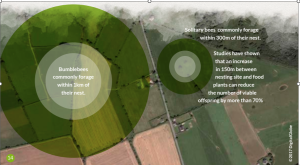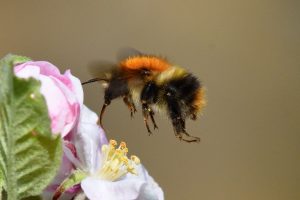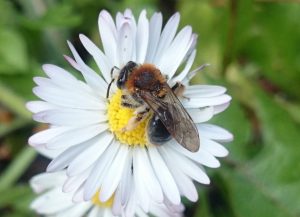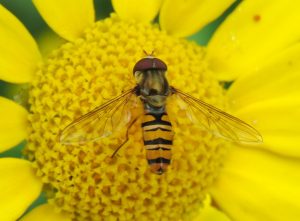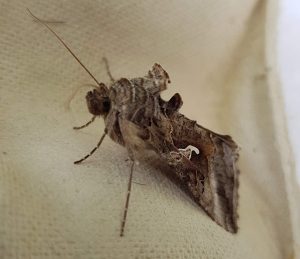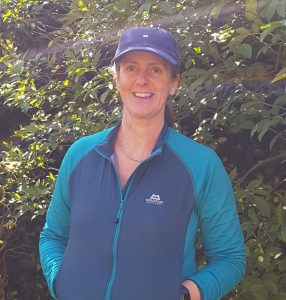Pollinator species are active at different times of day and at different times of the year. They have varying behaviour, body size and tongue length, flight distances, habitat and foraging preferences, and susceptibility to stressors and they vary in the plant species they pollinate.
Research has found different results, even for the same species. Factors affecting the travel of pollinators include the time of year and different environments.
Bumblebees
Larger social bees like bumblebees can have larger foraging range, research found some travelled just 100m from their nest, others went over 1km. They have bigger wings and can fly faster so it’s easier for them to cover more ground. So, bumblebees can differ greatly, but a common average forage distance is within 1km of their nest.
Common Carder bee Bombus pascuorum, forage around 1km from their nest. Photo: Andrew Malcolm.
Solitary bees
In general solitary bees do not fly great distances to find food, they commonly forage within 300m of their nest.
Orange-tailed mining bee Andrena haemorrhoa, do not fly great distances to find food. Photo: Isobel-Abbott
Hoverflies
Hoverflies are a little different from bees, as they are not restricted to a limited home range and may carry pollen over longer distances than bees while foraging and over considerably longer distances during migration.
Some adult hoverflies strategically use powerful tailwinds to travel hundreds of kilometres in a day and will migrate in spring from Mainland Europe to lay eggs in southern parts of Ireland. Each female can lay up to 400 eggs and, though many die as eggs or larvae, the departing population in autumn is larger than that arriving in spring.
Some hoverflies may also be present in very high densities, which is particularly true of migratory species. Radar studies of two common European species, the Marmalade hoverfly Episyrphus balteatus and the Migrant hoverfly Eupeodes corollae estimated up to 4 billion individuals move over southern Britain each year, monitored between 2000 and 20091. In and around farmland, hoverflies are often many times more abundant than all wild bee species, and this natural abundance may make up for potentially being not as efficient pollinators as wild bees.
This means hoverflies provide ecosystem functions not seen in bees, such as their ability to carry out long-distance pollen transfer, they also help with crop protection from pests and recycling of organic matter.
Marmalade hoverfly Episyrphus balteatus, a migratory hoverfly species. Photo: Steven Falk.
Moths
An adult moth lives for about a week, and many don’t eat during this final stage of their lives (they have no mouth); their sole function is to mate and, for the females, to lay eggs and start the next generation.
The moths that do feed as adults are important pollinators of plants and can complement the daytime pollinators.
Most moths have wings which give them the advantage of being able to lift off and look over a larger area for food. This food can come in the form of nectar from flowers, juices from rotting and fresh fruit or sap.
Although most moths are nocturnal, there are some we can all see easily during the day. Burnet moths and cinnabar moths are red and black, and fly during the day. We also get migrants from southern Europe here during warm weather, such as silver-Y moths.
A male moth can smell a female moth from a great distance. Moths don’t have a nose, but their antennae can detect odour molecules called pheromones.
So, moth travelling distances can vary greatly.
Silver-Y moth, numbers can be boosted with migratory species from southern Europe, during warm weather. Photo: Ruth Wilson.
Factors that can affect the travelling distances of pollinators
- Flower abundance. How many flowering plants are nearby.
- Networks and Corridors. When moving between their nest and feeding sites most pollinators like to follow linear features like hedgerows which give them some protection from the wind and rain. So, hedgerows and other linear landscape features on farmland can increase the connectivity between otherwise isolated plant and pollinator populations, so well-connected networks are important to increase pollinator movement and pollen transfer.
- Temperature and seasonality. In summer wild bees and other pollinators may have to travel further to forage. Spring can be a time of great flower abundance, which will mean pollinators can forage locally. Even though weather may be less favourable in the autumn, Ivy can be a valuable local source of food for pollinators, if available.
Connecting it all together!
- Check there is a seasonal food supply on your farm, that’s from early spring through to late autumn
- Native hedgerows as wide and tall as possible can provide a great seasonal food supply for pollinators. Think – Willow, Blackthorn, Hawthorn/Whitethorn, Dog rose, Guelder rose, Elder, etc.
- Field margins are a vital resource, as a food supply, especially next to a non-flowering crop and for nests, overwintering and hibernating pollinators.
- Think about where and how we use pesticides. If they are being used, it’s important to have pesticide free areas, hedgerows with wide field margins and non-farmed areas where pollinators can take refuge.
- Connecting it all together – it’s great if you can look at connecting hedgerows, field margins, small groups of trees and woodland areas together. Check if nesting sites are located close to good food sources (flowers). Nesting habitats are useless for pollinators if flowers are too far away.
For further information:
Visit our pollinator plan https://pollinators.ie/farmland/ where we have a page dedicated to farmland information and resources that can help you take the next steps, to carry out actions for pollinators on your farm.
References
1. Pollination by hoverflies in the Anthropocene. Toby Doyle, Will L. S. Hawkes, Richard Massy, Gary D. Powney, Myles H. M. Menz and Karl R. Wotton. Published:20 May 2020.
By Ruth Wilson, Farmland Officer, All-Ireland Pollinator Plan

